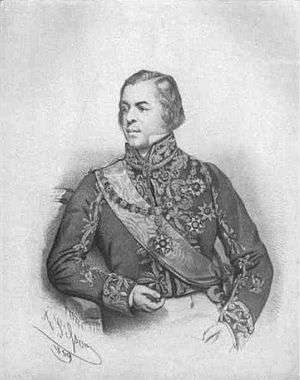Felisberto Caldeira Brant, Marquis of Barbacena

Felisberto Caldeira Brant Pontes de Oliveira Horta, the Marquis of Barbacena (1772-1842) was a soldier and statesman of both Portugal and the Empire of Brazil.[1]
Life
Brant was born in Portugal in 1772. He attended the Royal College of Nobles in Lisbon, eventually becoming an officer in the Portuguese army. Early in his career, Brant was sent to Angola, where he served as aide de camp to the royal governor there. In 1807, during the French invasion of Portugal, the Prince Regent, Dom João VI, fled to Brazil with a large retinue. Brant, who had by then returned to Portugal, accompanied the Prince Regent to South America. There, he became a pioneer in the field of steam transportation, developing such an interest in the method that he was granted official authorization to study it.[2]
By 1821, the Prince Regent had returned to Portugal, leaving his son Dom Pedro I in control of Brazil. Relations between the two regions grew tense, and Brazil broke away from the kingdom. Brant supported Dom Pedro, now the Emperor, being sent on a diplomatic mission to London by José Bonifácio, the minister for both internal and foreign affairs. He met little success during his stay in England, and he returned to Brazil by 1826.During the Cisplatine War (1825-1828) with Argentina, Brant rose to become commander-in-chief of Brazilian forces. He commanded the Brazilian army during a failed invasion of Argentina, and was fought to a draw in the Battle of Ituzaingó. In 1829, Brant was charged with finding a bride for Dom Pedro. He succeeded in this mission, but fell from grace shortly afterward. He died in 1842.
References
- ↑ "Official biography" (in Portuguese). Ministry of Finance of Brazil. Retrieved 25 April 2013.
- ↑ GOMES, Laurentino. 1808 - Como uma rainha louca, um príncipe medroso e uma corte corrupta enganaram Napoleão e mudaram a história de Portugal e do Brasil. São Paulo : Editora Planeta do Brasil, 2007, p.190.
.svg.png)